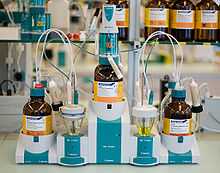Karl Fischer titration

Karl Fischer titration is a classic titration method in analytical chemistry that uses coulometric or volumetric titration to determine trace amounts of water in a sample. It was invented in 1935 by the German chemist Karl Fischer.[1]
Coulometric titration
The main compartment of the titration cell contains the anode solution plus the analyte. The anode solution consists of an alcohol (ROH), a base (B), SO2 and I2. A typical alcohol that may be used is methanol or diethylene glycol monoethyl ether, and a common base is imidazole.
The titration cell also consists of a smaller compartment with a cathode immersed in the anode solution of the main compartment. The two compartments are separated by an ion-permeable membrane.
The Pt anode generates I2 when current is provided through the electric circuit. The net reaction as shown below is oxidation of SO2 by I2. One mole of I2 is consumed for each mole of H2O. In other words, 2 moles of electrons are consumed per mole of water.
- B·I2 + B·SO2 + B + H2O → 2BH+I− + BSO3
- BSO3 + ROH → BH+ROSO3−
The end point is detected most commonly by a bipotentiometric method. A second pair of Pt electrodes are immersed in the anode solution. The detector circuit maintains a constant current between the two detector electrodes during titration. Prior to the equivalence point, the solution contains I− but little I2. At the equivalence point, excess I2 appears and an abrupt voltage drop marks the end point. The amount of charge needed to generate I2 and reach the end point can then be used to calculate the amount of water in the original sample.
Volumetric titration
The volumetric titration is based on the same principles as the coulometric titration except that the anode solution above now is used as the titrant solution. The titrant consists of an alcohol (ROH), base (B), SO2 and a known concentration of I2. Pyridine has been used as the base in this case.
One mole of I2 is consumed for each mole of H2O. The titration reaction proceeds as above, and the end point may be detected by a bipotentiometric method as described above.
Advantage of analysis
The popularity of the Karl Fischer titration is due in large part to several practical advantages that it holds over other methods of moisture determination, including:
- High accuracy and precision - typically within 1% of available water, e.g. 3.00% appears as 2.97 - 3.03%.
- Selectivity for water
- Small sample quantities required
- Easy sample preparation
- Short analysis duration
- Nearly unlimited measuring range (1ppm to 100%)
- Suitability for analyzing:
- Solids
- Liquids
- Gases
- Independence of presence of other volatiles
- Suitability for automation
- Linearity - single-point calibration, no calibration curves necessary
In contrast, loss on drying will detect the loss of any volatile substance.
The major disadvantage is that the water has to be accessible and easily brought into methanol solution. Many common substances, especially foods such as chocolate, release water slowly and with difficulty, and require additional efforts to reliably bring the total water content into contact with the Karl Fischer reagents.
References
- ↑ Fischer, Karl (1935). "Neues Verfahren zur maßanalytischen Bestimmung des Wassergehaltes von Flüssigkeiten und festen Körpern". Angew. Chem. 48 (26): 394–396. doi:10.1002/ange.19350482605.
Literature
- Water determination by Karl Fischer Titration by Peter A. Bruttel, Regina Schlink, Metrohm AG